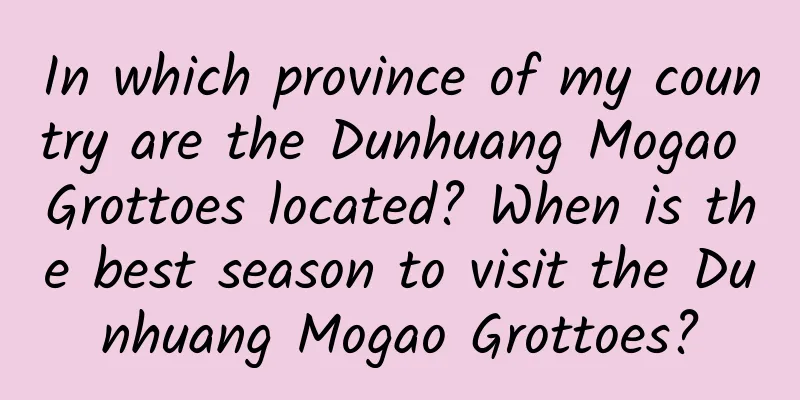In which province of my country are the Dunhuang Mogao Grottoes located? When is the best season to visit the Dunhuang Mogao Grottoes?

|
Going to Mogao Grottoes can improve your cultural literacy. After the Western Wei Dynasty, the background color was mostly white, the color tone tended to be elegant, the style was free and easy, and it had the style of the Central Plains. Typical caves include Cave 249, Cave 259, Cave 285, Cave 428, etc. For example, the statue of Sakyamuni in Cave 243 from the Northern Wei Dynasty, sitting upright, wearing an Indian cassock diagonally, with a flat round bun on the top of the head, retaining the Gandhara style. So in which province of my country is the Dunhuang Mogao Grottoes located? What is the best season to visit the Dunhuang Mogao Grottoes? Let's take a look at the introduction of Encyclopedia Knowledge Network below! Contents of this article 1. In which province of my country are the Dunhuang Mogao Grottoes located? 2. What is the best season to visit Dunhuang Mogao Grottoes? 3. In which dynasty were the Mogao Grottoes in Dunhuang excavated? 4. Introduction to Mogao Grottoes in Dunhuang, Gansu 1In which province of my country are the Mogao Grottoes of Dunhuang located?Dunhuang Mogao Grottoes, also known as the Thousand Buddha Caves, are located in the embrace of Mingsha Mountain and Sanwei Mountain in Gansu Province. It is the largest and most famous Buddhist art grotto in my country with a total of 492 caves, and is one of the three major grottoes in China along with Longmen Grottoes and Yungang Grottoes. On the cliff at the eastern foot of Mingsha Mountain in Dunhuang City, Gansu Province, a long plank road connects the large and small grottoes in a winding way. The walls of the caves are covered with murals and colored sculptures related to Buddhism, with solemn and dignified Buddha shadows and dancing flying apsaras, which are solemn and mysterious, making people hold their breath. 2What is the best season to visit Dunhuang Mogao Grottoes?Autumn is the best time to visit Dunhuang Mogao Grottoes. May to October is the best time to visit Dunhuang. Dunhuang is located deep inland, blocked by high mountains and far away from the humid ocean air. It has an arid continental climate with an average annual temperature of 9.3 degrees. It is dry and rainy all year round, with a large temperature difference between day and night. Dunhuang Mogao Grottoes is the general name of Mogao Grottoes and Western Thousand Buddha Caves in Dunhuang City, Gansu Province. It is one of the four famous grottoes in my country and the largest and best-preserved Buddhist art treasure house in the world. Mogao Grottoes is located 25 kilometers southeast of Dunhuang City and is carved on the cliffs at the eastern foot of Mingsha Mountain. It is about 1,600 meters long from north to south, with five layers arranged up and down, high and low in a staggered manner, lined up in rows, shaped like a beehive pigeon house, and is extremely spectacular. It is the largest and most content-rich treasure house of classical culture and art in my country, and is also a world-famous Buddhist art center. It was listed as a World Cultural Heritage by UNESCO in December 1987. 3In which dynasty were the Mogao Grottoes in Dunhuang excavated?1. Mogao Grottoes are located on the cliff at the eastern foot of Mingsha Mountain, 25 kilometers southeast of Dunhuang City, Gansu Province, China. It faces the Dangquan River in front and faces east. It is 1,680 meters long from north to south and 50 meters high. The caves are scattered and lined up, with up to five floors. 2. During the Northern Wei, Western Wei and Northern Zhou dynasties, the rulers believed in Buddhism, and the construction of grottoes was supported by the princes and nobles, and developed rapidly. During the Sui and Tang dynasties, with the prosperity of the Silk Road, Mogao Grottoes flourished even more. During the reign of Wu Zetian, there were more than a thousand caves. 3. After the An-Shi Rebellion, Dunhuang was occupied by Tubo and Guiyi Army, but the statue-making activities were not greatly affected. In the Northern Song Dynasty, Western Xia Dynasty and Yuan Dynasty, Mogao Grottoes gradually declined, and the main focus was on rebuilding the caves of the previous dynasties, with very few new ones built. In modern times, people usually call it the Thousand Buddha Caves. 4Introduction to Mogao Grottoes in Dunhuang, GansuMogao Grottoes, commonly known as the Thousand Buddha Caves, are located in Dunhuang at the western end of the Hexi Corridor. It was first built during the Former Qin period of the Sixteen Kingdoms, and has been built over the course of the Sixteen Kingdoms, Northern Dynasties, Sui, Tang, Five Dynasties, Western Xia, and Yuan dynasties. It has become a huge site with 735 caves, 45,000 square meters of murals, and 2,415 clay sculptures. It is the largest and most content-rich Buddhist art site in the world. Mogao Grottoes, commonly known as the Thousand Buddha Caves, is a group of caves with rich contents and magnificent scale dating back more than 2,000 years. It is the largest, longest-standing, richest and best-preserved treasure house of Buddhism and grotto art in my country and the world. It is one of the four major grottoes in my country. It was excavated on the cliff at the eastern foot of Mingsha Mountain, 25 kilometers southeast of Dunhuang City, facing Dangquan in front and Sanwei Mountain, a branch of Qilian Mountain in the east. It is 1,680 meters long from north to south. There are 735 caves built in successive dynasties, distributed on cliffs 15 to 30 meters high, with 1 to 4 layers distributed up and down. It is divided into two areas, the south and the north. The south area is a place for Buddhist worship activities. There are 492 caves with murals and colored sculptures from the Northern Liang, Northern Wei, Western Wei, Northern Zhou, Sui, Tang, Five Dynasties, Northern Song, Uighur, Western Xia, and Yuan dynasties, more than 2,400 colored sculptures, more than 45,000 square meters of murals, five wooden cave eaves from the Tang and Song dynasties, and a nine-story building that was rebuilt in the early Republic of China as the symbol of Mogao Grottoes. There are more than 20 lotus pillars and stupas, and more than 20,000 floor tiles. The 243 caves in the north area are places for monks to practice, live, and be buried. There are earthen kangs, stoves, flues, niches, and lampstands for practice and living facilities, but most of them have no colored sculptures or murals. Each cave in Mogao Grottoes is a comprehensive art of cave architecture, colored sculpture and painting. The largest cave is more than 200 square meters, and the smallest is less than 1 square meter. The caves mainly include Zen caves, central tower column caves, Buddha niche caves, Buddha altar caves, Nirvana caves, seven Buddha caves, and large statue caves. The colored sculptures combined with sculpture and painting mainly include Buddha, Bodhisattva, disciples, heavenly kings, and strong men. The colored sculptures are in the form of round sculptures, relief sculptures, shadow sculptures, and good deeds mud. Except for the two big Buddhas in Caves 96 and 130 and the two big reclining Buddhas in Caves 148 and 158, which are stone-based clay sculptures, the rest of the round sculptures and relief sculptures are wood-framed clay sculptures. The Buddha statue is in the center, with disciples, Bodhisattvas, heavenly kings, and strong men standing on both sides, with at least 3 and at most 11. The 35.6-meter Maitreya seated statue in Cave 96 is the tallest, and the smallest is more than 10 centimeters. Exaggerated colors are often used to express the character of the characters, with different expressions. Its rich content can be called a thousand-year history of ancient Chinese Buddhist colored sculptures. The murals are rich in content and are divided into seven categories: Buddhist statues, Buddhist story paintings, Buddhist historical relics paintings, sutra paintings, gods and monsters paintings, donor portraits, and decorative patterns. The wide variety of murals reflects the social reality of ancient times from many aspects, and provides extremely precious visual historical materials for the study of my country's feudal social history, culture, politics, economy, science and technology, military, religion, architecture, transportation, clothing, music and dance, and folk customs. Therefore, it is internationally hailed as a museum on the wall, the world's longest gallery, and a visual history spanning a thousand years. |
<<: Why are Mogao Grottoes called Mogao Grottoes? In which year were Mogao Grottoes first built?
Recommend
What should I do if I have lower abdominal pain during my period?
If you feel pain in your lower abdomen during you...
If there is plaque in the carotid artery, can I still exercise? Will exercise cause the plaque to fall off?
A friend complained to Huazi that plaques were fo...
Why does a woman’s private parts have an odor?
Gynecological diseases are something that every w...
What to do with pelvic fluid accumulation after abortion? There are ways to remove the fluid
In modern life, many female friends suffer from g...
Can postpartum stretch marks be removed?
Many mothers after childbirth will be troubled by...
Yellow green discharge in pregnant women
Because women have special reproductive organs, t...
What to do if a pregnant woman has two plus signs in her urine protein
Pregnant women need to undergo checkups during pr...
Can I drink yogurt during menstruation?
During menstruation, women's physical conditi...
What causes lower abdominal pain and missed menstruation?
A woman’s first menstruation indicates that she h...
Why do my legs hurt during menstruation?
Many female friends experience uncomfortable symp...
Can taking folic acid help you conceive twins?
Women who want to get pregnant often have a beaut...
How to monitor ovulation? Tell you the effective method
Women's ovulation period is a very complicate...
What are the reactions to insufficient amniotic fluid?
If there is insufficient amniotic fluid, pregnant...
What are some ways to get your period early?
For some women, having menstruation at certain ti...
Hallux valgus is ugly, should it be treated?
Author: Tang Qin, Deputy Secretary-General of the...









